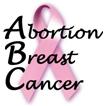CME course credit for ABC research
Press Release
Contact: Karen Malec
For Immediate Release
Date: January 20, 2003
Study Says Tell Women about Research Exploring Abortion-Breast Cancer Link; Study Offered as CME Course to Ob/Gyns 30 years after Roe v. Wade
A recent study examining a variety of physical and psychological consequences associated with abortion calls for physicians to inform women about a breast cancer risk known to scientists for 33 years 1 (the delayed first term pregnancy effect) and about the existence of research examining abortion as an independent risk factor for breast cancer.
The study, Thorpe et al. 2, noted that its authors did not reach a consensus on the question of an independent link between abortion and breast cancer. An independent link would mean that the procedure leaves a woman with more cancer vulnerable cells than she had before her pregnancy. However, they said, “Whatever the effect of induced abortion on breast cancer risk, a young woman with an unintended pregnancy clearly sacrifices the protective effect of a term delivery should she decide to abort and delay childbearing.”
Specifically, the paper cites a 1996 review and meta-analysis of abortion-breast cancer studies, Brind et al. 1996. 3 In addition, it cites separate reviews by David Grimes, M.D. 4, an abortionist and colleague of John Thorpe’s at the University of North Carolina, and Tim Davidson, M.D. 5.
Thorpe and his colleagues inaccurately reported the risk elevation found by Brind et al. as being 20%. In fact, Brind and his colleagues at Penn State found a 30% increased risk for women choosing an abortion after first full term pregnancy and a 50% risk elevation for women choosing an abortion before a first full term pregnancy.
Each of the reviews relied upon by Thorpe et al. cite the erroneous study, Melbye et al. 1997. 6 That study has been severely criticized for errors of misclassification and data adjustment, as well as for its failure to report in its conclusions a statistically significant 89% increased risk for women procuring abortions after 18 weeks of pregnancy. 7 8
Other negative risks cited by the paper as being associated with abortion include: increased risk of pre-term birth (which is known to be associated with cerebral palsy), placenta previa, mood disorders and suicide.
Significantly, the study, published in the journal, Obstetrical and Gynecological Survey, is offered as a CME review. This means that physicians can receive course credit for studying the paper.
Karen Malec, the president of a women’s organization, the Coalition on Abortion/Breast Cancer, said, “We are pleased that, after nearly a half century, doctors are finally being encouraged to inform women about the existence of ongoing research exploring an independent link between abortion and breast cancer. However, women also have the right to know that there is overwhelming biological and epidemiological evidence supporting an independent relationship between abortion and the disease. Clearly, it is beneficial to women when their doctors are pro-information.”
Mrs. Malec added, “If physicians inform their patients about the delayed first term pregnancy effect associated with abortion, then perhaps they can help turn around the soaring rates of breast cancer. Women need to know more than just the fact that late first term pregnancies are related to risk increases. They need to be informed that the earlier they have their first full term pregnancies, the lower their risk for breast cancer will be.”
The Coalition on Abortion/Breast Cancer is an international women’s organization founded to protect the health and save the lives of women by educating and providing information on abortion as a risk factor for breast cancer.
- 1. MacMahon B. et al. Bull. Wld Health Org. (1970) 43-209-21.
- 2. Thorpe J. et al. Obstetrical & Gynecological Survey (2003) 58(1):67-79.
- 3. Brind J, et al. JNCI (1996) 50:481-96.
- 4. Bartholomew LL, Grimes DA. Obstet Gynecol Surv (1998) 53(11).
- 5. Davidson T. The Lancet Oncology (2001) Vol. 2.
- 6. Melbye M, et al. N Engl J Med (1997) 336(2):81-5.
- 7. Brind J, Chinchilli V. N Engl J Med (1997) 336:1834.
- 8. Senghas & Dolan N Engl J Med (1997) 336:1834.




